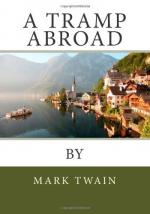From the north cage one looks up the Neckar gorge; from the west one he looks down it. This last affords the most extensive view, and it is one of the loveliest that can be imagined, too. Out of a billowy upheaval of vivid green foliage, a rifle-shot removed, rises the huge ruin of Heidelberg Castle, [2. See Appendix B] with empty window arches, ivy-mailed battlements, moldering towers—the Lear of inanimate nature—deserted, discrowned, beaten by the storms, but royal still, and beautiful. It is a fine sight to see the evening sunlight suddenly strike the leafy declivity at the Castle’s base and dash up it and drench it as with a luminous spray, while the adjacent groves are in deep shadow.
Behind the Castle swells a great dome-shaped hill, forest-clad, and beyond that a nobler and loftier one. The Castle looks down upon the compact brown-roofed town; and from the town two picturesque old bridges span the river. Now the view broadens; through the gateway of the sentinel headlands you gaze out over the wide Rhine plain, which stretches away, softly and richly tinted, grows gradually and dreamily indistinct, and finally melts imperceptibly into the remote horizon.
I have never enjoyed a view which had such a serene and satisfying charm about it as this one gives.
The first night we were there, we went to bed and to sleep early; but I awoke at the end of two or three hours, and lay a comfortable while listening to the soothing patter of the rain against the balcony windows. I took it to be rain, but it turned out to be only the murmur of the restless Neckar, tumbling over her dikes and dams far below, in the gorge. I got up and went into the west balcony and saw a wonderful sight. Away down on the level under the black mass of the Castle, the town lay, stretched along the river, its intricate cobweb of streets jeweled with twinkling lights; there were rows of lights on the bridges; these flung lances of light upon the water, in the black shadows of the arches; and away at the extremity of all this fairy spectacle blinked and glowed a massed multitude of gas-jets which seemed to cover acres of ground; it was as if all the diamonds in the world had been spread out there. I did not know before, that a half-mile of sextuple railway-tracks could be made such an adornment.
One thinks Heidelberg by day—with its surroundings —is the last possibility of the beautiful; but when he sees Heidelberg by night, a fallen Milky Way, with that glittering railway constellation pinned to the border, he requires time to consider upon the verdict.
One never tires of poking about in the dense woods that clothe all these lofty Neckar hills to their beguiling and impressive charm in any country; but German legends and fairy tales have given these an added charm. They have peopled all that region with gnomes, and dwarfs, and all sorts of mysterious and uncanny creatures. At the time I am writing of, I had been reading so much of this literature that sometimes I was not sure but I was beginning to believe in the gnomes and fairies as realities.




